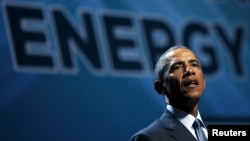U.S. President Barack Obama arrived in Paris late Sunday with the weight of a climate legacy and expectations that nations big and small, rich and poor, can come together around the common cause of protecting the planet.
“What makes this gathering different is that more than 180 nations have already submitted plans to reduce the harmful emissions that help cause climate change. And America's leadership is helping to drive this progress,” Obama said.
In a Facebook post Sunday, Obama noted he was “optimistic about what we can achieve” during the United Nations conference in the French capital.
Unlike Copenhagen, the U.S. leader will join other heads of state to launch the 195-nation summit, a move White House officials hope will generate momentum for a successful outcome during the remaining two weeks of negotiations.
“We knew a new approach would be needed to rally all nations to take action,” said National Security Council Senior Director for Energy and Climate Change Paul Bodnar.
Global climate goal
The summit’s goal is to limit average global warming to 2 degrees Celsius, perhaps less, compared to pre-Industrial Revolution levels by curbing fossil fuel emissions that are blamed for climate change.
Just this year, the U.N.'s weather agency said the average global temperature is set to rise by 1 degree Celsius, halfway to the limit the U.N. is seeking to impose.
But adoption of mandatory controls throughout the world is far from certain at the Paris summit. An attempt in Copenhagen in 2009 to craft a global deal floundered at an ill-tempered summit, with divisions between rich and poor countries.
“We concluded that climate targets should be set by countries themselves and, not imposed on them; that all countries should be expected to act even though developing countries faced unique challenges; and that we should expect strong transparency and accountability from all countries,” Bodnar told reporters in a press call.
The White House’s senior energy and climate change director noted some 170 countries, representing 90 percent of global emissions, have now put forward post-2020 targets that will help limit “global temperature rise to 2.7 degrees Celsius by the end of the century, compared to 4.1 to 4.8 degrees that would happen without action.”
On Monday, President Obama will meet the leaders of two of the world’s largest carbon emitters, Chinese President Xi Jinping and Indian Prime Minister Narendra Modi, to build on climate talks held over the last year.
‘Mission Innovation’
Obama, Modi and Xi will also join other world leaders Monday to announce the “Mission Innovation” initiative aimed at accelerating clean energy research and development (R&D), with a focus on developing countries which need affordable technology to curb emissions.
The president’s chief climate advisor, Brian Deese, said 20 countries are committing to doubling their governments’ investment in clean energy R&D over the next five years.
He said the nations represent roughly 75 percent of global carbon dioxide emissions from the electricity sector and about 80 percent of global clean energy R&D, or $10 billion annually.
“Mission Innovation” is coupling with “The Breakthrough Energy Coalition” - a private sector effort spearheaded by Bill Gates, that also includes global business leaders Jack Ma, Ratan Tata, and Richard Branson.
White House officials say the coalition, which represents about $350 billion in wealth, is committing to investing in high-risk, early-stage clean energy projects to move them from the laboratory to the marketplace in countries participating in Mission Innovation.
In a Sunday call with reporters, Deese cited how U.S. investments in clean energy technology have led to drops in the prices of solar-voltaic modules by 80 percent and LED prices by 90 percent, noting the same can be done on a global scale.
“We not only take steps to deploy clean energy through development assistance, but that public and private sectors are investing in clean energy R&D to drive down the prices of deployable technologies and make clean energy markets self-sufficient and thriving in developing countries,” Obama’s climate advisor said.
Deese said the focus on access for developing countries is key to reaching an overall agreement in Paris.
Paris security
Obama’s visit to Paris follows Islamic State terrorist attacks there that killed at least 130 people on November 13.
France says that about 2,800 police and soldiers are securing the Le Bourget conference site, and 6,300 others will deploy in Paris. French Interior Minister Bernard Cazeneuve said nearly 1,000 people believed to pose security risks have been denied entry into France.
On Sunday, activists linked hands in the heart of the French capital amid the tight security. But peaceful protests turned violent, with police firing tear gas at a small group of demonstrators and arresting about 100.
With French officials banning marches, those who had wanted to demonstrate instead symbolically left about 20,000 pairs of shoes on the ground at the Place de la Republique, Some were even left by U.N. Secretary General Ban Ki-moon. Demonstration organizers said the shoes weighed four tons and also included a pair the Vatican sent on behalf of Pope Francis.
President Obama and his French counterpart Francois Hollande are expected to discuss the campaign to counter Islamic State during a working dinner on Monday.
During a November 24 joint press conference with Hollande, Obama said the climate conference would send a message of global unity in the wake of the Paris attack.
Ken Bredemeier contributed to this report from Washington.











